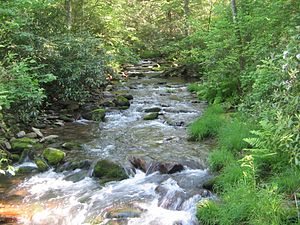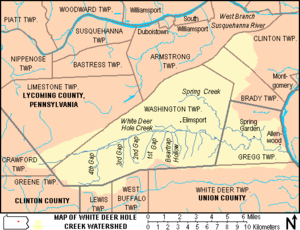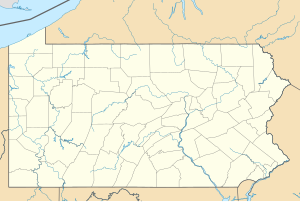White Deer Hole Creek
| White Deer Hole Creek | |
|
White Deer Hole Creek near the Fourth Gap of South White Deer Ridge
|
|
| Name origin: Lenape language Woap-achtu-woalhen | |
| Country | United States |
|---|---|
| State | Pennsylvania |
| Counties | Clinton, Lycoming, Union |
| Tributaries | |
| - left | Spring Creek |
| - right | Beartrap Hollow |
| Source | |
| - location | Crawford Township, Clinton County |
| - elevation | 2,180 ft (664 m) |
| - coordinates | 41°05′19″N 77°11′38″W / 41.08861°N 77.19389°W |
| Mouth | West Branch Susquehanna River |
| - location | Gregg Township, Union County |
| - elevation | 445 ft (136 m) |
| - coordinates | 41°06′02″N 76°53′22″W / 41.10056°N 76.88944°WCoordinates: 41°06′02″N 76°53′22″W / 41.10056°N 76.88944°W |
| Length | 20.5 mi (33.0 km) |
| Basin | 67.2 sq mi (174.0 km2) |
| Discharge | for Mouth |
| - average | 70.4 cu ft/s (1.99 m3/s) |
| - max | 111 cu ft/s (3.14 m3/s) |
| - min | 33 cu ft/s (0.93 m3/s) |
|
Map showing White Deer Hole Creek, its major tributaries and watershed
|
|
White Deer Hole Creek is a 20.5-mile (33.0 km) tributary of the West Branch Susquehanna River in Clinton, Lycoming and Union counties in the U.S. state of Pennsylvania. A part of the Chesapeake Bay drainage basin, the White Deer Hole Creek watershed drains parts of ten townships. The creek flows east in a valley of the Ridge-and-valley Appalachians, through sandstone, limestone, and shale from the Ordovician, Silurian, and Devonian periods.
As of 2006, the creek and its 67.2-square-mile (174 km2) watershed are relatively undeveloped, with 28.4 percent of the watershed given to agriculture and 71.6 percent covered by forest, including part of Tiadaghton State Forest. The western part of White Deer Hole Creek has very high water quality and is the only major creek section in Lycoming County classified as Class A Wild Trout Waters, defined by the Pennsylvania Fish and Boat Commission as "streams which support a population of naturally produced trout of sufficient size and abundance to support a long-term and rewarding sport fishery." The rest of the creek and its major tributary (Spring Creek) are kept . There are opportunities in the watershed for canoeing, hunting, and camping, and trails for hiking and horseback riding.
...
Wikipedia



